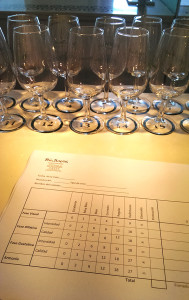D.O. Official Tasting – Part 2
November 17th, 2015 | Denomination
 Our D.O. office has a very nice, new tasting room. Light and airy, with individual booths, each with lamp (to aid in the visual phase) and a small sink for spitting – bottled water is also supplied. Every wine tasted has its own tasting sheet, and of course can be any type of wine recognised by the D.O. – 100% Albariño, blends of recognised white grapes (these are classified as Rias Baixas and cannot be called Albariño unless 100%), red wines, and the latest addition, sparkling wines. The maximum number of wines for any one tasting is 15.
Our D.O. office has a very nice, new tasting room. Light and airy, with individual booths, each with lamp (to aid in the visual phase) and a small sink for spitting – bottled water is also supplied. Every wine tasted has its own tasting sheet, and of course can be any type of wine recognised by the D.O. – 100% Albariño, blends of recognised white grapes (these are classified as Rias Baixas and cannot be called Albariño unless 100%), red wines, and the latest addition, sparkling wines. The maximum number of wines for any one tasting is 15.
Tasting sheets are divided into six sections – visual phase, orafactory phase (intensity + quality), tasting phase (intensity + quality), and finally ‘harmony’ or balance. Now this is where (in my opinion), the system is a bit whacky! The better the wine, the lower the score! A wine that is considered excellent in any phase actually scores zero points for that phase…. The scoring system varies from 0 points for excellent to a maximum of 27 points for a completely defective phase, with more points being allocated to the more important phases such as taste and balance. There is actually a column on the sheet whereby any wine can simply be eliminated out of hand, should it be so bad!
It’s a bit complicated to explain, but results in each wine having a final score – up to 62 points will pass the tasting, but anything higher will automatically fail, and can be submitted for re-tasting at a later date. (Two failures means that it cannot be sold as a D.O.wine) I should mention that wines can, and do sometimes fail the tasting, but the names of the wines that pass or fail are never given to the members of the tasting panel, even after the tasting is completed.
Assuming that the wine passes the tasting the ‘tirillas’ can be allocated. These are numbered consecutively, meaning that they can be traced back to the tank/bottles in question. However, for some reason they are not issued immediately, and by regulation the bodega has to wait a further three days before they can be collected – but wait….. this doesn’t mean that a bodega can simply grab the tirillas and start bottling at will. When the tank in question has passed and is finally ready, the bodega still needs to provide the D.O. office with 24 hours notice of intention to bottle! This then gives the D.O. the opportunity to organise an inspection (always at random) to finally ensure that the correct tank is being used, in conjunction with the correct tirillas.
Simple.


